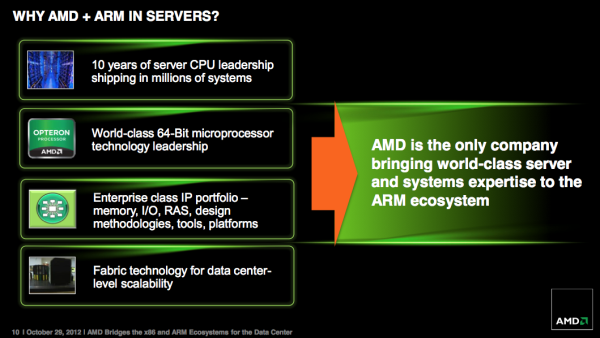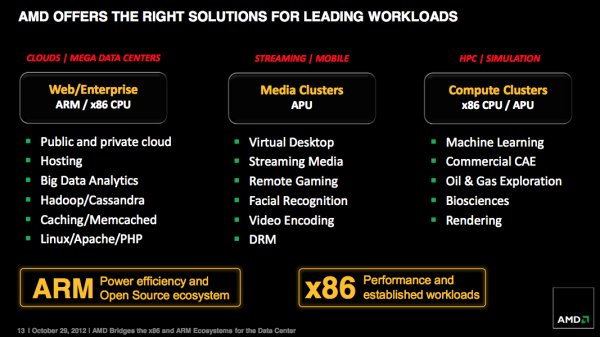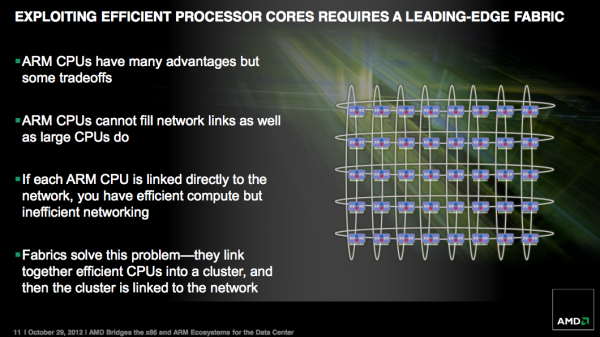AMD Will Build 64-bit ARM based Opteron CPUs for Servers, Production in 2014
by Anand Lal Shimpi on October 29, 2012 4:48 PM EST- Posted in
- Cloud Computing
- CPUs
- IT Computing
- AMD
- Arm
- Opteron
Last year AMD officially became an ARM licensee, although the deal wasn't publicized at the time. Fast forward to June 2012 and we saw the first fruits of that deal: AMD announced it would integrate ARM's Cortex A5 core into its 2013 APUs to enable TrustZone support.
Today comes a much bigger announcement: AMD will be building Opteron processors based on a 64-bit ARM architecture. There are no product announcements today, but the 64-bit ARM Opterons will go into production in 2014. Today's announcement is about a processor license, not an ARM architecture license - in other words, AMD will integrate an ARM designed 64-bit core for this new Opteron. Update: AMD will integrate ARM's new Cortex-A50 series of 64-bit ARMv8 CPU cores.
The only other detail we know is that these ARM based Opterons will embed SeaMicro's Freedom Fabric, presumably on-die.
AMD offering ARM based Opterons is really to target the microserver market. As for why AMD isn't using Jaguar for these parts, it's likely that by going with ARM it can lower the development time and cost to get into this market. The danger here is the total microserver market is expected to be around 10% of the overall server market, but that includes x86 + ARM. With x86 as the default incumbent, it's going to be an uphill battle for AMD/ARM to carve out a significant portion of that market.
AMD was quick to mention that despite today's announcement, it will continue to build x86 CPUs and APUs for client and server markets.
Overall the move sounds a lot like AMD trying to move quickly to capitalize on a new market. It's unclear just how big the ARM based server market will be, but AMD seems to hope that it'll be on the forefront of that revolution - should it happen. Embracing ARM also further aligns AMD with one of Intel's most threatening sources of competition at this point. The question is whether or not AMD is doing itself more harm than good by working to devalue x86 in the server space. I suspect it'll be years before we know the real impact of AMD's move here.
The other major takeaway is that AMD is looking to find lower cost ways of bringing competitive platforms to market. I do think that a Jaguar based Opteron would likely be the best route for AMD, but it would also likely require a bit more effort than integrating an ARM core.
Obviously competition will be more prevalent in the ARM server space, but here is where AMD hopes its brand and position in the market will be able to give it an advantage. AMD will also be relying heavily on the SeaMicro Freedom Fabric for giving its ARM based Opterons a leg up on the competition. This is one time where I really wish AMD hadn't spun off its fabs.













32 Comments
View All Comments
MySchizoBuddy - Monday, October 29, 2012 - link
a custom core can come later own just like how Apple did it.Beenthere - Monday, October 29, 2012 - link
This is a good step forward for AMD in a developing market segment. It will be another revenue stream which is smart Biz.Jaybus - Wednesday, October 31, 2012 - link
The market is still unclear at this point. The Samsung Exynos 4210 has 2 A9 cores with a TDP of 4.5 W and at 1.2 GHz achieves 1,380 MIPS in the 7zip LZMA compression benchmark. The two core i3 2100 at 3.1 GHz with a TDP of 65 W achieves 8,800 MIPS in the same test. But the competition is really the Xeon E3 1220L which has 2 cores and a 17 W TDP.What I see is that Intel has had a power efficiency issue, whereas the ARM chips have a performance issue. But Intel is clearly getting better with, for example, the Xeon E3 1220L and its 17 W TDP at 2.3 GHz (3.5 GHz turbo). It would take at least 12 1.2 GHz A9 cores to match the performance of the E3 1220's 2 cores. Does the new 64-bit ARM core in the AMD chip gain enough in performance to compensate for the gains Intel has made in power efficiency?
The low power server market is really just not that clear. It is a risky move, which is why AMD is not designing its own ARM-based core just yet. But they have lost their competitveness in the high performance server market, so they are trying to branch out. There could be gains to be made in the ultra-low power server market, such as NAS boxes, media servers, etc.
Also, I wonder if AMD might be thinking about an ARM based APU SoC for the mobile market, since Apple seems to be at odds with Samsung these days.
fancarolina - Monday, October 29, 2012 - link
I hope they make this chip. This would be ideal for Windows 8 tablets. It would be able to turn off the x86 cores while in Metro and not doing anything heavy. Then when you fired up an x86 Application it can flip them on and you have the power of a full processor. You would get the best of both worlds ARM efficiency on the go and x86 application support when you want it.KitsuneKnight - Monday, October 29, 2012 - link
I don't believe AMD is going to be making any ARM+X86 CPUs (at least not based on this announcement). Maybe in the future... but I don't think that'd be an ideal situation. Certainly wouldn't be easy at all to handle.MySchizoBuddy - Monday, October 29, 2012 - link
How many cores will the opteron chips actually have?kukreknecmi - Monday, October 29, 2012 - link
""I do think that a Jaguar based Opteron would likely be the best route for AMD, but it would also likely require a bit more effort than integrating an ARM core.""What does "require a bit more effort" here means? Arent Jaguars already developed and ready to go? Does Jaguar needs special treatment to become a server chip like Atom based ones? From what i know, Jaguar is more or less can be produced in recent times, yet Arm based ones will be more than 1 year.
So again, why the Jaguar's way needs more effort ? Or AMD is up to something that ArmV8 based chip will be a beast and probably wipe Jaguar, so there is no need to insist?
mayankleoboy1 - Monday, October 29, 2012 - link
would it make sense to make a GPU from gluing together many ARM cores together with high bandwidth interconnects ?Ryan Smith - Tuesday, October 30, 2012 - link
In short, no. A GPU is fundamentally composed of many very simple math units, along with specialty units like texture units and ROPs. Not only would ARM cores be a poor choice for the math units (they're relatively complex) but it would still lack the kind of specialty units you need to flesh out the rest of the GPU.KitsuneKnight - Tuesday, October 30, 2012 - link
For a GPU? It'd likely be pretty horrible performance (or if you scaled it up enough, ignoring scaling limitations, horribly massive power consumption). While you might be able to get a lot of ARM cores for the same power as laptop/desktop GPUs, they'd likely take up a huge amount of physical space, and not have as good performance.The ARM cores would have a massive amount of silicon duplicated that wouldn't be used very much. It'd beat the GPU for workloads the GPU sucks at (ones GPUs aren't regularly used for... non-graphic stuff), but... it won't necessarily beat a similar x86 chip at that workload.
It'll be interesting to see where ARM actually manages to go, but I doubt it's as different from x86 as a lot of people like to assume. Intel has shown an amazing ability to produce an x86 chip that's actually in the same ballpark as ARM chips... we still need to see ARM produce (well, design) a chip with high performance (as in, something that's usable for random laptop/desktop workloads... not just light tablet workloads).